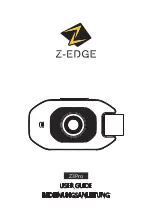
III. EQUIPMENT AND GENERAL INFORMATION
A. Tools and equipment needed to carry out testing
procedures in this guide:
Grounded soldering iron
DVM
Oscilloscope
Power supply
Zero ohm test probe
1000 ohm probe
B. Power Consumption:
All measurements made with typical camera connected
through a DVM to a regulated 2.9v power supply.
Circuits off (clock on) 17 micro-amps
Circuits on...................................... 0,6 ma
Shutter open ......... 7.5 ma
Battery Check 9 ma
Flash mode 6 ma
Self-timer 12 ma
C. Typical coil resistance:
Opening curtain magnet, MG-1 , . . 54 ohms. Measure
between Q-201's collector and the leg of C-210 nearest the
front of the camera.
Closing curtain magnet, MG-2..........580 ohms. Measure
between the body and Q-202's collector, the pin nearest
the front
D. Preparation for troubleshooting:
1. All DVM and scope measurements should be made
with reference to the negative side of the power supply.
For convenience, you may want to solder a short wire to
the board at TP-2, then use that as a reference.
2. Most tests can be made with only the top cover
removed. If the bottom cover is removed, you will need to
connect a power supply or use a cut-off bottom cover to
hold the batteries.
3. Use a strap lug for B+ or Vcc source.
4. If you need to power up the circuits with lens off, first
press the small black button near the red index dot on the
bayonet ring.
5. Remove the cover plate in front under the mirror to
gain access to MG-2 and the shutter board,
6. The index mark straight to the back on the ASA
resistor is ASA 100. Zero exposure compensation is the
mark at two o'clock.
7. With the top removed, logic switches for "Spot,"
"Clear," "Memo," etc., are disconnected. To program
those modes, use tweezer tips to momentarily connect
wire solder pads or pins on IC-101 as indicated:
"Spot" Gray to Red or Pins 16 and 17
"Memory" . Yellow to Brown or Pins 18 and 14
"Clear" .... Yellow to Red or Pins 16 and 18
8. The circuit may be cleared by moving the Mode
Switch to the battery check position.
9. Take care to avoid static electricity damage to ICs
when covers are off the camera.
10. Take full advantage of the comprehensive viewfinder
LCD to aid your troubleshooting. Check each function
to determine what works and what doesn't. ESTABLISH
THE EXACT SYMPTOMS BEFORE YOU BEGIN
TO TROUBLESHOOT
IV. ADJUSTMENT PROCEDURE
Trigger delay (Timing Switch), BV, and Direct Ev
adjustments can be reached through a cutout in the front
plate above the Self-Timer Switch,
If possible, use a power supply instead of batteries during
adjustment. Set supply voltage at 3.0v.
1. Test manual speeds at 1/8 (117ms, +/-0) and 1/2000
(0.49ms, +/-0.2ms). Adjust 1/8 speed with VR-101.
Adjust 1/2000 speed with VR-102, the trigger delay
under the front leather nearest the wind side.
2. Set ASA 100, f-5.6, and LV-10, and mode to "Auto."
Be sure "Spot" mode is not used and exposure correction
factor on ASA dial is zero. Use film or surface of similar
reflectivity on tester sensor face.
Try several test exposures, then adjust for near zero
exposure error using VR-110, under the front leather
nearest the lens. Check the exposure at higher ASAs (up
to 3200) and fine tune if necessary using VR-103, Try to
ma/- 0.3 Ev over ASA range.
3. Set ASA 100, f-4, "Auto" (not "Spot") and LV-11.
Adjust VR-105, under the front leather at the center, so
the LCD bar graph indicates 1/125.
4. Set ASA 100, f-4, "Auto," and LV-11. Press the
"Spot" button; the index dot should indicate 1/125.
Adjust using VR-106
5. If auto exposure in "Spot" mode is not correct, DAC
reference voltage may be incorrect. Set ASA 3200,
correction factor to zero. Using a DVM, measure the
voltage between Vref (DVM common lead) and DAC
output at pin 46, IC-102, At room temperature, 21
degrees centigrade, the voltage should be 198mv, Adjust
with VR-108.
OLYMPUS OM-4, PAGE 5
Summary of Contents for OM-4
Page 22: ...OLYMPUS OM 4 PAGE 22...






































